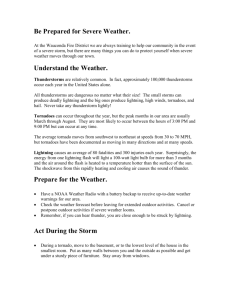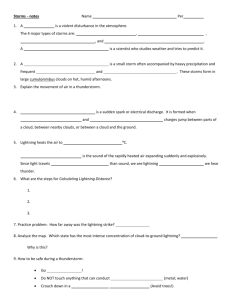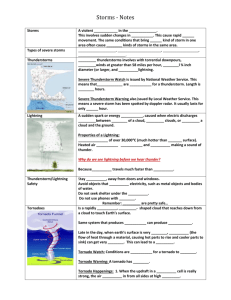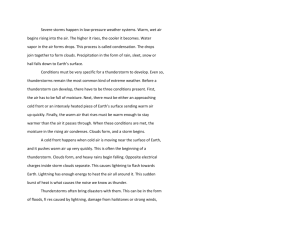Chapter 14
advertisement
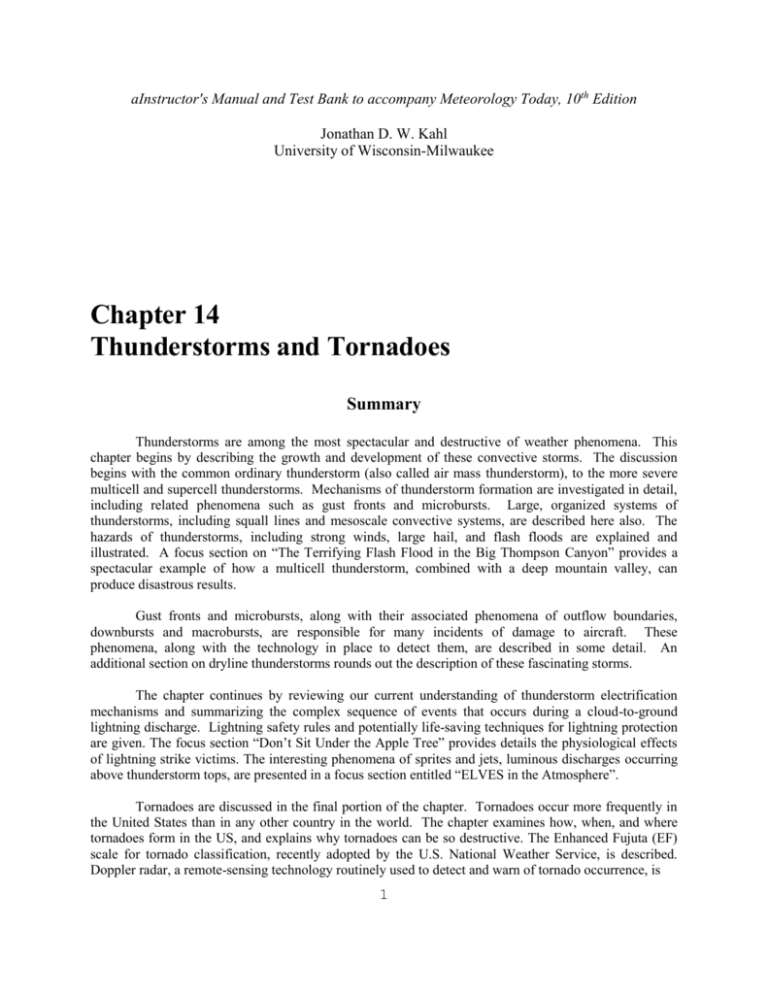
aInstructor's Manual and Test Bank to accompany Meteorology Today, 10th Edition Jonathan D. W. Kahl University of Wisconsin-Milwaukee Chapter 14 Thunderstorms and Tornadoes Summary Thunderstorms are among the most spectacular and destructive of weather phenomena. This chapter begins by describing the growth and development of these convective storms. The discussion begins with the common ordinary thunderstorm (also called air mass thunderstorm), to the more severe multicell and supercell thunderstorms. Mechanisms of thunderstorm formation are investigated in detail, including related phenomena such as gust fronts and microbursts. Large, organized systems of thunderstorms, including squall lines and mesoscale convective systems, are described here also. The hazards of thunderstorms, including strong winds, large hail, and flash floods are explained and illustrated. A focus section on “The Terrifying Flash Flood in the Big Thompson Canyon” provides a spectacular example of how a multicell thunderstorm, combined with a deep mountain valley, can produce disastrous results. Gust fronts and microbursts, along with their associated phenomena of outflow boundaries, downbursts and macrobursts, are responsible for many incidents of damage to aircraft. These phenomena, along with the technology in place to detect them, are described in some detail. An additional section on dryline thunderstorms rounds out the description of these fascinating storms. The chapter continues by reviewing our current understanding of thunderstorm electrification mechanisms and summarizing the complex sequence of events that occurs during a cloud-to-ground lightning discharge. Lightning safety rules and potentially life-saving techniques for lightning protection are given. The focus section “Don’t Sit Under the Apple Tree” provides details the physiological effects of lightning strike victims. The interesting phenomena of sprites and jets, luminous discharges occurring above thunderstorm tops, are presented in a focus section entitled “ELVES in the Atmosphere”. Tornadoes are discussed in the final portion of the chapter. Tornadoes occur more frequently in the United States than in any other country in the world. The chapter examines how, when, and where tornadoes form in the US, and explains why tornadoes can be so destructive. The Enhanced Fujuta (EF) scale for tornado classification, recently adopted by the U.S. National Weather Service, is described. Doppler radar, a remote-sensing technology routinely used to detect and warn of tornado occurrence, is 1 2 described in detail. The chapter concludes with a brief discussion of waterspouts. A final focus section describes “Forecasting Severe Thunderstorms and Tornadoes”. Teaching Suggestions 1. The growth and decay of an ordinary (air mass) thunderstorm is illustrated well on time-lapse videos. Many such videos can be found on youtube.com and shown to the class. 2. Spectacular video footage of tornadoes, often obtained by amateur photographers using home video equipment, is available for purchase from several sources. Youtube.com is a good source of still and video images of tornadoes, thunderstorms and lightning. 3. Discuss any recent tornadoes that may have occurred. A good resource for this is: http://www.tornadopaths.org 4. Discuss methods for photographing lightning. surprisingly difficult. Photographing lightning during daytime is 5. Discuss why wind gusts in the vicinity of thunderstorms often feel cool rather than warm. This is an opportunity to integrate the concepts of adiabatic warming and evaporative cooling and turbulence. 6. Have students take photographs of local thunderstorms and post them to the class Facebook site. Hopefully you can get several photographs of the same storms for a comparative discussion. 7. Locate a thunderstorm on a 00Z surface chart, and find the corresponding radiosonde report using the University of Wyoming’s radiosonde data website. Use the sounding data to determine the temperature that 500 hPa air would have if brought to the surface in a downdraft. http://weather.uwyo.edu/upperair/sounding.html 8. Invite the students to share their personal experiences of lightning or tornadoes. In a large class, there are likely to be at least a few students with interesting stories. Student Projects 1. Depending on location and time of the year, students might use data from morning surface and upper-level charts to prepare forecasts of thunderstorm activity for the coming afternoon or evening. Let the students decide which of the various weather elements or simple stability indices might be appropriate. Students should validate their forecast and attempt to improve forecast accuracy. 2. Thunderstorms and lightning are good choices for student photography projects. Photographs of a developing thunderstorm taken at intervals of 5 or 10 minutes will often illustrate how rapidly 3 cumulonimbus clouds can develop. 3. If nighttime thunderstorm activity is frequent, students can attempt to photograph the cloud-toground lightning. The camera will probably need to be located several kilometers away from the thunderstorm and out of the rain. By slowly panning the (tripod-mounted) camera, it might be possible to resolve the separate strokes in a lightning flash (see, for example, J. Hendry Jr., "Panning for Lightning," Weatherwise, 45, 19, 1993.) 4. Have students explain why golfball-sized hail is only possible in thunderstorms with exceptionally strong updrafts. 5. Have students interview a friend or family member regarding their personal experience with a tornado. Answers to Questions for Review 1. A storm containing lightning and thunder. 2. Warm, humid air masses away from significant weather fronts. 3. The first stage is known as the cumulus stage, or growth stage. As a parcel of humid air rises, it cools and condenses into a single cumulus cloud or a cluster of clouds. During the cumulus stage, there normally is insufficient time for precipitation to form, and the updrafts keep water droplets and ice crystals suspended within the cloud. Also, there is no lightning or thunder during this stage. The appearance of the downdraft marks the beginning of the mature thunderstorm. The downdraft and updraft within the mature thunderstorm constitute a cell. During its mature stage, the thunderstorm is most intense. After the storm enters the mature stage, it begins to dissipate in about 15 to 30 minutes. The dissipating stage occurs when the updrafts weaken as the gust front moves away from the storm and no longer enhances the updrafts. 4. As the cloud builds well above the freezing level, the cloud particles grow larger. They also become heavier. Eventually, the rising air is no longer able to keep them suspended, and they begin to fall. While this phenomenon is taking place, drier air from around the cloud is being drawn into it in a process called entrainment. The entrainment of drier air causes some of the raindrops to evaporate, which chills the air. The air, now colder and heavier than the air around it, begins to descend as a downdraft. The downdraft may be enhanced as falling precipitation drags some of the air along with it. 5. Because air near the ground is typically most unstable in the afternoon. 6. Unlike the ordinary thunderstorm which weakens once it enters the dissipation stage, the supercell storm is an enormous rotating thunderstorm whose updrafts and downdrafts are sufficiently structured so that the storm is able to maintain itself as a single entity for hours on end. Storms of this type are capable of producing updrafts that can exceed 90 knots, hail the size of grapefruit, damaging surface winds, and large, long-lasting tornadoes. Normally, precipitation does not form in the region of 4 the strong updraft. If precipitation does form, it may be swept laterally out of the region by the rapidly rotating air. 7. A thunderstorm having at least one of the following: large hail with a diameter of at least threequarters of an inch, surface wind gusts of 50 knots (58 mph) or greater, or produces a tornado. 8. Change of wind speed with altitude; change of wind direction with altitude. 9. The cold downdraft of mature and dissipating thunderstorms, upon reaching the surface, may force warm, moist surface air upward along its advancing edge. This rising air then condenses and gradually builds into a new thunderstorm. This process may repeat over and over as old cells die out and new ones form. Thus, it is entirely possible for a series of thunderstorms to grow in a line, one next to the other, each in a different stage of development. Thunderstorms that form in this manner are termed multicell storms. Most ordinary thunderstorms are multicell storms, as are many severe thunderstorms. 10. A gust front is the leading edge of cold air originating inside a thunderstorm. During its passage, the wind shifts and becomes strong and gusty, with speeds occasionally exceeding 55 knots; temperatures drop sharply and, in the cold heavy air of the downdraft, the surface pressure often rises—sometimes several millibars. 11. Beneath an intense thunderstorm, the downdraft may become localized so that it hits the ground and spreads horizontally in a radial burst of wind, much like water pouring from a tap and striking the sink below. Such downdrafts are called downbursts. A downburst with winds extending only 4 km or less is termed a microburst. In the area of a microburst, rapid changes in wind speed or wind direction (wind shear) poses a serious hazard to aircraft. 12. When damage associated with straight-line winds extends for several hundred kilometers along the path of a squall line, the storm is called a derecho. 13. MCCs are large, circular convective systems. Squall lines are linear features. 14. The surging nature of the main cold front itself, or developing cumulus clouds along the front, may cause the air aloft to develop into waves (called gravity waves), much like the waves that form downwind of a mountain chain. Out ahead of the cold front, the rising motion of the wave may be the trigger that initiates the development of cumulus clouds and a pre-frontal squall line. 15. The updraft in a supercell thunderstorm is longer-lasting and rotates. 16. If the winds aloft become even stronger (strong shear) and change direction with height (from more southerly at the surface to more westerly aloft), the storm may move along in such a way that the outflow of cold air from the downdraft never undercuts the updraft. The wind shear may be strong enough to create horizontal spin, which when tilted into the updraft causes it to rotate. In this situation, the thunderstorm may grow into a larger, long-lasting (longer than an hour) severe storm called a supercell that has a violent updraft and a single cell. 17. HP supercells (for High Precipitation), often produce extreme downdrafts (called downbursts), 5 flash flooding, and very large hail. If tornadoes are present, it is often difficult to see them, as they tend to form in the area of heavy precipitation. A supercell characterized by little precipitation is referred to as an LP supercell (for Low Precipitation). 18. When thunderstorms are training they keep passing over the same area, like railroad cars, one after another, passing over the same tracks. 19. In western Texas, Kansas and Oklahoma. 20. In the southeastern states along the Gulf Coast with a maximum in Florida, because there is plenty of available moisture, unstable surface air, and convergence. 21. Conditions over the Great Plains are more favorable for the development of severe thunderstorms. 22. One theory proposes that clouds become electrified as graupel and hail fall through a region of supercooled droplets and ice crystals. As liquid droplets collide with a hailstone, they freeze on contact and release latent heat. This process keeps the surface of the hailstone warmer than that of the surrounding ice crystals. When the warmer hailstone comes in contact with a colder ice crystal, an important phenomenon occurs: There is a net transfer of positive ions from the warmer object to the colder object. Hence, the hailstone becomes negatively charged and the ice crystal positively charged, as the positive ions are incorporated into the ice. 23. Thunder is the sound that results from the rapidly expanding heated air along the channel of the lightning stroke. 24. Cloud-to-ground lightning begins within the cloud when the localized electric potential gradient exceeds 3 million volts per meter along a path perhaps 50 m long. This situation causes a discharge of electrons to rush toward the cloud base and then toward the ground in a series of steps. Each discharge covers about 50 to 100 m, then stops for about 50-millionths of a second, then occurs again over another 50 m or so. This stepped leader is very faint and is usually invisible to the human eye. As the tip of the stepped leader approaches the ground, the potential gradient (the voltage per meter) increases, and a current of positive charge starts upward from the ground (usually along elevated objects) to meet it. After they meet, large numbers of electrons flow to the ground and a much larger, more luminous return stroke several centimeters in diameter surges upward to the cloud along the path followed by the stepped leader. 25. As the electrons approach the ground, a region of positive charge moves up into the air through any conducting object, such as trees, buildings, and even humans. Because a positive charge tends to concentrate in upward projecting objects, such as trees, the upward return stroke that meets the stepped leader is most likely to originate from such objects. Thus it is unsafe to stand near a tree during an electrical storm. 26. The typical cloud-to-ground lightning flash is called negative cloud-to-ground-lightning, because the stroke carries negative charges from the cloud to the ground. About 90 percent of all cloud-to-ground lightning is negative. However, when the base of the cloud is positively charged and the ground negatively charged, a positive cloud-to-ground lightning flash may result. Positive lightning, most common with severe thunderstorms, has the potential to cause more damage because it generates a much 6 higher current level and its flash lasts for a longer duration than negative lightning. 27. A funnel cloud is a tornado whose circulation has not reached the ground. 28. The diameter of most tornadoes is between 100 and 600 m (about 300 to 2000 ft), although some are just a few meters wide and others have diameters exceeding 1600 m (1 mi). They tend to move from the southwest toward the northeast at speeds usually between 20 and 40 knots. 29. It appears that opening windows during a tornado actually increases the pressure on the opposite wall and increases the chances that the building will collapse. Also, windows are usually shattered by flying debris and it is wise to stay away from them. 30. The Central Plains region is most susceptible to tornadoes because it provides the proper atmospheric setting for the development of the severe thunderstorms that spawn tornadoes. Here (especially in spring) warm, humid surface air is overlain by cooler, drier air aloft, producing a conditionally unstable atmosphere. When a strong vertical wind shear exists and the surface air is forced upward, large thunderstorms capable of spawning tornadoes may form. 31. During the winter, tornadoes are most likely to form over the southern Gulf states when the polarfront jet is above this region, and the contrast between warm and cold air masses is greatest. In spring, humid Gulf air surges northward; contrasting air masses and the jet stream also move northward and tornadoes become more prevalent from the southern Atlantic states westward into the southern Great Plains. In summer, the contrast between air masses lessens, and the jet stream is normally near the Canadian border; hence, tornado activity tends to be concentrated from the northern plains eastward to New York State. 32. A tornado watch alerts the public that tornadoes may develop. A tornado warning means a tornado has already been spotted. 33. The safest place is usually in a small room such as a bathroom, closet or interior hallway near the middle of the building. 34. Rapidly increasing wind speed with height provides vertical wind speed shear and the changing wind direction with height – from southerly at low levels to westerly at high levels – provides wind direction shear, which induces the updrafts inside the storms to rotate. 35. When surface winds converge along a boundary of topographic irregularities, the rising air begins to spin due to fact that the winds are blowing from different (opposite directions). As the spinning, rising air shrinks in diameter, it produces a landspout, a tornado-like structure. 36. A radar transmitter sends out microwave pulses that, are scattered back to the antenna when the microwave energy strikes an object. Precipitation particles are large enough to bounce microwaves back to the antenna. Doppler radar works on the principle that, as precipitation moves toward or away from the antenna, the returning radar pulse will change in frequency. This change in frequency is called the Doppler shift and is used to distinguish the storm's air motions. 7 37. The NEXRAD network of Doppler radar units deployed at selected weather stations within the continental United States take in data, display it on monitors, and run computer programs called algorithms, which, in conjunction with other meteorological data, detect severe weather phenomena, such as storm cells, hail, mesocyclones, and tornadoes. The algorithms provide a great deal of information to the forecasters that allows them to make better decisions as to which thunderstorms are most likely to produce severe weather and possible flash flooding. In addition, they give advanced and improved warning of an approaching tornado. 38. Fair weather waterspouts tend to form in much the same way that landspouts do - when the air is conditionally unstable and cumulus clouds are developing. Some form with small thunderstorms, but most form with developing cumulus congestus clouds whose tops are frequently no higher than 3600 m (12,000 ft) and do not extend to the freezing level. Apparently, the warm, humid air near the water helps to create atmospheric instability, and the updraft beneath the resulting cloud helps initiate uplift of the surface air. Answers to Questions for Thought 1. The sinking air increases in strength in the middle and lower portion of the cloud, causing the liquid cloud particles to evaporate quickly. In the upper portion of the cloud, where ice particles prevail and downward motions are slight, the cloud particles survive for a long time. 2. As drier air is drawn into the cloud, some of the falling raindrops evaporate. This cools the sinking air. Actually, the sinking air beneath the cloud base probably warms, but at the moist adiabatic rate, not the dry adiabatic rate. Consequently, when the descending air reaches the surface it is cooler than the air it replaces. 3. The conditions that lead to the lifting of warm, humid air and the generation of a squall line usually occur in the warm sector ahead of an advancing cold front. Behind a cold front the air motions are usually downward, and the air is cooler and drier. 4. A “right moving” thunderstorm is one that moves to the right of the wind. 5. A lightning flash often consists of a series of very rapid strokes that strike the same spot many times. 6. Most tornadoes rotate counterclockwise. When facing an on-rushing tornado it would probably be wisest to run to your right and lie down in a depression. On this side of the twister the wind speed should be slightly lower. 7. The rapid decrease in pressure causes a lowering of the condensation level, and so the tornado cloud forms at successively lower altitudes. 8 Answers to Critical Thinking Questions Figure 14.12. It would be a bigger risk if the aircraft were taking off, as it would be closer to the ground when it experienced the microburst. Figure 14.47. The same. The greatest winds would be on the south side. 9 Multiple Choice Exam Questions 1. All thunderstorms require a. hot, humid air. b. divergence of the air aloft. c. lifting along some barrier such as a mountain or front. d. surface heating. e. rising air. ANSWER: E 2. The initial stage of an ordinary thunderstorm is the a. mature stage. b. dissipating stage. c. cumulus stage. d. multicell stage. ANSWER: C 3. Ordinary thunderstorms only last about one hour and begin to dissipate when a. lightning neutralizes all the electrical charge in the cloud. b. when all the precipitation particles in the cloud turn to ice. c. when the downdraft spreads throughout the cloud and cuts off the updraft. d. when solar heating at the ground begins to decrease. ANSWER: C 4. An ordinary thunderstorm is a a. thunderstorm that does not produce lightning or thunder. b. thunderstorm that has a tilted updraft and downdraft. c. scattered or isolated storm that is not severe. d. thunderstorm that does not produce hail. ANSWER: C 5. Downdrafts spread throughout a thunderstorm during the ____ stage. a. cumulus b. dissipating c. precipitating d. developing ANSWER: B 6. An ordinary thunderstorm is most intense during the ____ stage. a. mature 10 b. multicell c. cumulus d. dissipating ANSWER: A 7. The most likely time for an ordinary thunderstorm to form is a. just after sunrise. b. just before sunrise. c. around midnight. d. late afternoon. e. at noon. ANSWER: D 8. Severe thunderstorms are different from ordinary thunderstorms in that severe thunderstorms a. contain thunder and lightning. b. have an anvil. c. contain hail. d. have a strong updraft and downdraft. e. have a tilted updraft in the mature stage. ANSWER: E 9. Thunderstorms that produce tornadoes a. have very little cloud-to-ground lightning. b. have updraft velocities that exceed 100 miles per hour. c. have rotating updrafts. d. will not produce hail. ANSWER: C 10. The downdraft in an ordinary thunderstorm is created mainly by a. the melting of snow in the anvil. b. electrical attraction between the cloud and ground. c. the release of latent heat as water in the cloud freezes. d. evaporating raindrops that make the air cold and heavy. e. upper level wind motions. ANSWER: D 11. Which of the following would you not expect to observe during the passage of a gust front? a. gusty winds b. rising surface pressures c. increase in temperatures d. wind shift 11 ANSWER: C 12. A small thunderstorm cloud with virga falling out of its base and blowing dust at the ground could warn of a severe hazard to an airplane because a. this could be the first indication of a tornado. b. it is likely that hail will soon begin to fall. c. this could indicate an intense downdraft or microburst. d. the airplane could be struck by lightning. ANSWER: C 13. The wind shear associated with several major airline crashes is believed to have been caused by a. microbursts. b. dry lines. c. the jet stream. d. mesocyclones. ANSWER: A 14. During the summer, what conditions prevail near the surface over the Great Plains that help a hailstone survive as ice all the way to the ground? a. a warm, shallow layer of dry air b. a warm, thick layer of moist air c. a cold, shallow layer of dry air d. a cold, thick layer of moist air e. a warm, shallow layer of moist air ANSWER: A 15. Squall lines generally do not form a. behind a cold front. b. when the air aloft develops waves downwind from a cold front. c. along a dry line. d. in the warm sector where warm, dry air meets warm, humid air. e. ahead of an advancing cold front. ANSWER: A 16. Most squall line thunderstorms form a. in advance of a cold front. b. along a cold front. c. behind a cold front. d. in advance of a warm front. e. along an occluded front. 12 ANSWER: A 17. Many flash floods, including those that occurred in Rapid City, South Dakota, and in Colorado's Big Thompson Canyon, are the result of thunderstorms that a. contain no lightning. b. form in a dry air mass. c. move slowly. d. have weak or non-existent downdrafts. ANSWER: C 18. Which figure comes closest to the estimated number of thunderstorms that occur each year throughout the world? a. 2,000 b. 40,000 c. 100,000 d. 600,000 e. 14,000,000 ANSWER: E 19. Lightning may occur a. within a cloud. b. from a cloud to the ground. c. from one cloud to another cloud. d. all of the above ANSWER: D 20. Distant lightning that is so far away you cannot hear the thunder is called a. sheet lightning. b. heat lightning. c. false lightning. d. St. Elmo's fire. e. auroral lightning. ANSWER: B 21. Electrons a. are negatively charged. b. are positively charged. c. carry no charge. d. can carry either positive or negative charge. ANSWER: A 13 22. The upper part of a thunderstorm cloud is normally ____ charged, and the middle and lower parts are ____ charged. a. negatively, negatively b. negatively, positively c. positively, positively d. positively, negatively ANSWER: D 23. The electrification of a cumulonimbus cloud appears to involve a. graupel or hailstones. b. supercooled cloud droplets. c. ice crystals. d. all of the above ANSWER: D 24. An important principle in the electrification of a cumulonimbus cloud is that a. raindrops are always positively charged. b. supercooled water is always negatively charged. c. ice crystals are always negatively charged. d. there is a net transfer of positive ions from a warmer object to a colder object. ANSWER: D 25. A cloud-to-ground lightning discharge will sometimes appear to flicker. This is because a. you are able to see the separate steps of the stepped leader. b. you are able to distinguish separate return strokes. c. the bright light causes you to blink. d. of refraction caused by turbulent thunderstorm winds. ANSWER: B 26. You are generally safe inside an automobile during a lighting storm because a. the car's radio antenna will act as a lightning rod: b. the rubber tires insulate you from the ground. c. metal cars do not become electrically charged. d. the metal car body will carry the lightning current around the passengers inside. ANSWER: D 27. Which of the following is the most accurate description of the principle of a lightning rod? a. The lightning rod acts to discharge the thunderstorm. b. The lightning rod intercepts the lightning and safely carries the lightning current around the object it protects. c. Lightning rods have been used since the 1700s, but the principle of their operation is not 14 known. d. Positive charge induced in the lightning rod repels the negative charge in an approaching step leader. ANSWER: B 28. Thunder is caused by a. the collision between two thunderstorms with opposite electrical charge. b. the rapid heating of air surrounding a lightning channel. c. the explosion that occurs when + and - charge collide and neutralize each other. d. turbulent wind motions inside the thunderstorm. ANSWER: B 29. If you see a lightning stroke and then, 15 seconds later, hear the thunder, the lightning is about ____ miles away. a. 45 b. 15 c. 5 d. 3 ANSWER: D 30. Thunder will not occur a. without lightning. b. in wintertime thunderstorms. c. in thunderstorms over the ocean. d. when a thunderstorm is producing precipitation. ANSWER: A 31. When caught in a thunderstorm in an open field, the best thing to do is to a. run for cover under the nearest tree. b. lie down flat on the ground. c. crouch down as low as possible while minimizing contact with the ground. d. remove all metallic objects from your pockets. ANSWER: C 32. Which of the following statements about tornadoes is correct? a. All tornadoes rotate in a counterclockwise direction. b. Tornadoes never strike the same place twice. c. All tornadoes make a distinction roar. d. The United States has more tornadoes that any other country in the world. ANSWER: D 15 33. The funnel cloud characteristic of a tornado is principally formed by a. condensation of water vapor in air drawn into the low pressure core of the tornado. b. dust and dirt picked up from the atmosphere. c. clouds being funneled by downward air currents coming out of a cumulonimbus cloud. d. water drawn up from the sea surface into the cloud. e. gaseous products from intense lightning activity within the tornado. ANSWER: A 34. In a typical tornado the winds are usually not much more than ____ miles per hour. a. 25 b. 50 c. 100 d. 200 ANSWER: C 35. Most tornadoes move from a. northwest to southwest. b. southwest to northeast. c. south to north. d. southeast to northwest. ANSWER: B 36. Which of the following factors is most important in determining the strength of a tornado? a. diameter b. air temperature c. duration d. central pressure ANSWER: D 37. If a tornado is rotating in a counterclockwise direction and moving toward the northeast, the strongest winds will be on its ____ side. a. southwestern b. southeastern c. northeastern d. northwestern ANSWER: B 38. A typical diameter of a tornado would be a. 50 meters. b. 250 meters. 16 c. 1,000 meters. d. 2,500 meters. e. 4,000 meters. ANSWER: B 39. The most frequent time of day for tornadoes to form is in the a. early morning just after sunrise. b. late morning just before noon. c. evening just after sunset. d. afternoon. e. middle of the night. ANSWER: D 40. ____. In the United States, tornadoes are most frequent during the ____, and least frequent during the a. b. c. d. e. summer, fall spring, winter spring, fall summer, winter winter, fall ANSWER: B 41. Tornadoes are usually observed a. behind cold fronts. b. on the windward side of mountains. c. near large bodies of water. d. along occluded fronts. e. ahead of cold fronts. ANSWER: E 42. In an eastward moving thunderstorm, the most likely place for a tornado to develop is in the ____ part of the storm. a. northeast b. southeast c. northwest d. southwest ANSWER: D 43. In a region where severe thunderstorms with tornadoes are forming, one would not expect to observe a. a strong ridge of high pressure over the region. 17 b. a dry tongue of cold air between the 700 and 500 mb levels. c. the polar jet stream above the region. d. moist warm air moving north at about the 850 mb level. ANSWER: A 44. At home, when confronted with an approaching tornado, you should a. open the windows right away. b. grab a video camera and start filming. c. listen to see whether the tornado has an audible roar. d. seek shelter immediately. ANSWER: D 45. The Enhanced Fujita Scale for classifying tornado strength is based on a. multiple damage indicators. b. degree of damage. c. atmospheric stability. d. multiple damage indicators and the degree of damage. e. none of the above ANSWER: D 46. Damage to structures inflicted by tornadoes can be caused by a. flying debris. b. the tornadoes high winds. c. the drop in air pressure as a tornado moves overhead. d. the drop in air pressure above a roof as high winds blow over it. e. all of the above ANSWER: E 47. After a tornado is spotted, a. a tornado watch is issued. b. its direction of movement is carefully monitored by aircraft. c. a tornado warning is issued. d. hail begins to fall from the cloud. e. attempts may be made to change its direction of movement. ANSWER: C 48. The signal detected by a Doppler radar is a. a radiowave emitted by lightning. b. a soundwave produced by thunder. c. a radiowave reflected by precipitation. d. a soundwave produced by wind shear. 18 ANSWER: C 49. Supercell thunderstorms ____ become severe. a. rarely b. occasionally c. often d. always ANSWER: C 50. Strong vertical wind shear a. does not play an important role in the development of severe thunderstorms. b. inhibits the formation of severe thunderstorms. c. helps thunderstorms to become severe. ANSWER: C Essay Exam Questions 1. List and discuss some of the atmospheric conditions that are needed for a thunderstorm to develop. 2. List and describe the stages of development of an ordinary thunderstorm. About how long does a single ordinary thunderstorm cell last? 3. Where does the energy contained in a mature thunderstorm come from? 4. In what ways are multicell thunderstorms different from ordinary thunderstorms? What are some of the meteorological or atmospheric conditions that favor the development of multicell thunderstorms? 5. What is wind shear? Why does wind shear represent a hazard to aviation? 6. What is a squall line? Where would you expect squall lines to form? 7. Where do thunderstorms form most frequently in the US? Why is this the case? Is this also where most tornadoes occur? Explain. 8. List and describe the sequence of events that occur during a cloud-to-ground lightning discharge. 9. Do invisible tornadoes exist? Why or why not? 10. Compare some damaging straight-line winds with tornado winds. Which do you think are more 19 destructive? 11. What makes a tornado-producing thunderstorm different from other thunderstorms? 12. The region of greatest tornado activity shifts northward from early spring to summer. Why does this occur? 13. Most tornadoes move from the southwest toward the northeast. Why is this true? 14. The fact that thunder sometimes sounds like a loud crash or peal, and other times sounds like a dull rumble, has nothing to do with the intensity of the lightning strike that produced the thunder. Explain why. 15. How does a supercell thunderstorm differ from a multicell thunderstorm?
